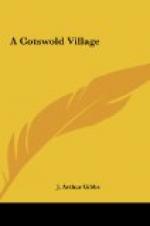The “Diary of Master William Silence” tells us that the quiet little hamlets presented an unusually gay appearance on these memorable occasions. “The village green was covered with booths. There were attractions of various kinds. The churchwardens had taken advantage of the unusual concourse of strangers as the occasion of a Church ale. Great barrels of ale, the product of malt contributed by the parishioners according to their several abilities, were set abroach in the north aisle of the church, and their contents sold to the public. This was an ordinary way of providing for church expenses, against which earnest reformers inveighed, but as yet in vain so far as Shallow was concerned. The church stood conveniently near the village green, and the brisk trade which was carried on all day was not interrupted by the progress of divine service.” The parson’s discourse, however, appears to have suffered some interruption by reason of the numbers who crowded into the aisles to patronise the churchwardens’ excellent ale.
In the reign of James I. one, Robert Dover, revived the old Olympic games on Cotswold. Dover’s Hill, near Weston-under-Edge, was called after him.
These sports included horse-racing, coursing, cock-fighting, and such games as quoits, football, skittles, wrestling, dancing, jumping in sacks, and all the athletic exercises.
The “Annalia Dubrensia” contain many verses about these sports by the hand of Michael Drayton, Ben Jonson, and others.
“On Cotteswold
Hills there meets
A greater troop
of gallants than Rome’s streets
E’er saw
in Pompey’s triumphs: beauties, too,
More than Diana’s
beavie of nymphs could show
On their great hunting days.”
That hunting was practised here in these days is evident, for Thomas Randall, of Cambridge, writes in the same volume:
“Such royal pastimes
Cotteswold mountains fill,
When gentle swains
visit Anglonicus hill,
When with such
packs of hounds they hunting go
As Cyrus never
woon’d his bugle to.”
Fozbrooke tells us that the Whitsuntide sports are the floralia of the Romans. They are still a great institution in all parts of the Cotswolds, though Church ales, like cock-fighting and other barbaric amusements, have happily long since died out.
Golf and archery are popular pastimes in the merry Cotswolds. It is somewhat remarkable that this district has produced in recent years the amateur lady champions of England in each of these fascinating pastimes, Lady Margaret Scott, of Stowell, being facile princeps among lady golfers, whilst Mrs. Christopher Bowly, of Siddington, even now holds the same position in relation to the ancient practice of archery.
The ancient art of falconry is still practised in these parts. Thirty years ago, when Duleep Singh lived at Hatherop, hawking on the downs was one of his chief amusements. But the only hawking club hereabouts that we know of is at Swindon, in Wiltshire.




